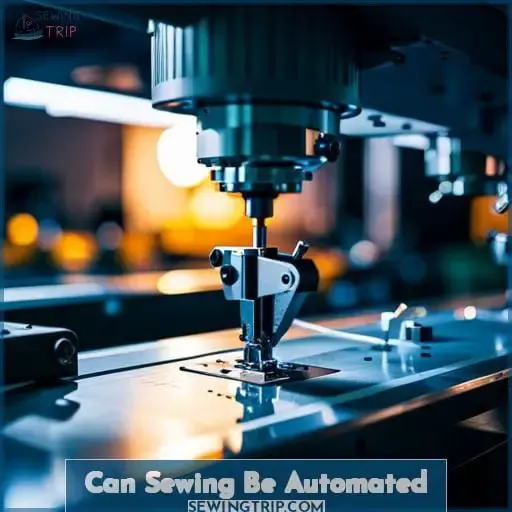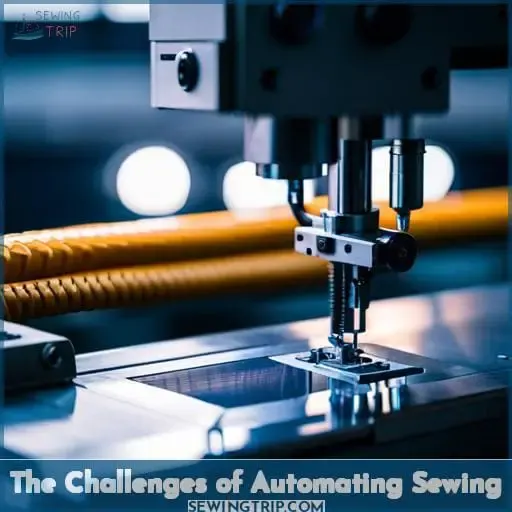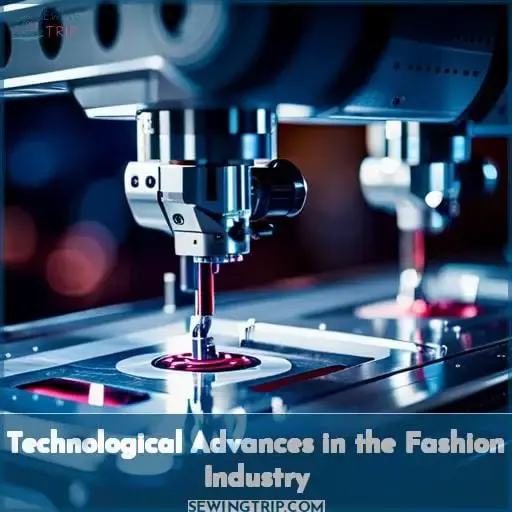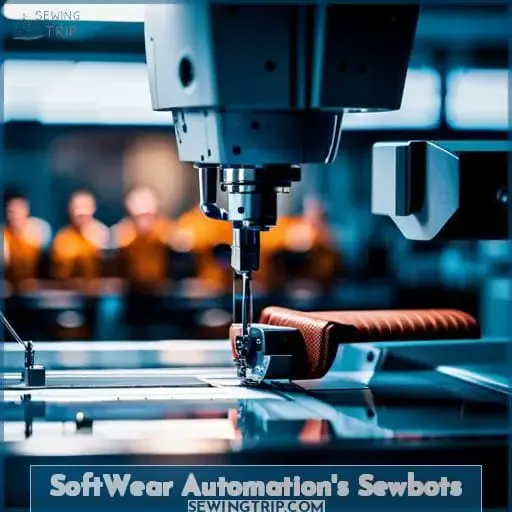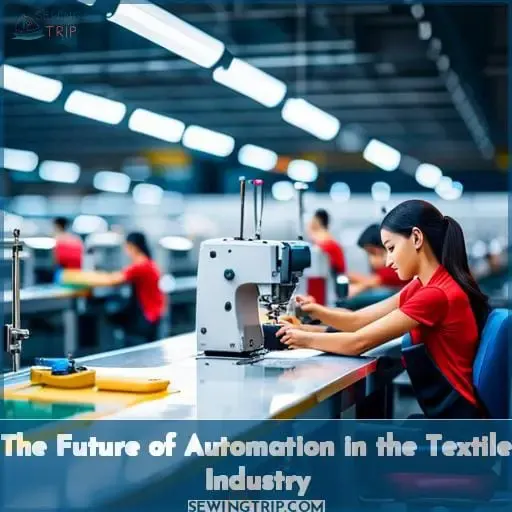This site is supported by our readers. We may earn a commission, at no cost to you, if you purchase through links.
Sewing has been a major part of the fashion industry for centuries, but can it be automated? With technological advances in robotics and other machines, automation is becoming more accessible to clothing manufacturers.
However, there are challenges that come with automating sewing processes that must be considered before making this transition.
In this article, we will explore the potential of automation within the garment industry and how it could affect jobs around the world. We will look at SoftWear Automation’s Sewbots, as well as other technologies being developed to automate sewing, and discuss their impact on both people involved in production and consumers alike.
Table Of Contents
Key Takeaways
- SoftWear Automation’s Sewbots can produce garments, including T-shirts, at a faster rate and with higher precision than manual labor.
- Automation in the fashion industry can reduce labor exploitation while still producing ethical clothing at an efficient rate.
- The fashion industry must prioritize fair wages and safe working conditions, even with the adoption of automation technology.
- The responsible use of automation is essential in the technological age, balancing the benefits of increased efficiency with social responsibility for worker well-being.
The Challenges of Automating Sewing
You may have heard of SoftWear Automation, a robotics company that has been striving to manufacture T-shirts on demand in the US with its robotic Sewbots. The challenge is creating robots that can work 24/7 at high speeds and with greater than 98 percent accuracy.
Remote monitoring allows for accurate tracking of fabric types, labor costs, and machine maintenance while maintaining precision in the stitching process. While automating such intricate tasks like garment manufacturing often requires human hands due to differing cuts or styles, it takes more time for them compared to the automated system where lines must be created first before production could begin.
It is difficult for machines to reconfigure quickly from one type of garment to another, hence why SoftWear will need multiple facilities each equipped with their own skilled workers and Sewbots. This would eventually create higher paying jobs despite potentially ruining millions of other lives who depend on clothing industry jobs abroad.
Technological Advances in the Fashion Industry
Technology is revolutionizing the fashion industry with automated sewing machines, robotic cutting, computerized knitting, and 3D printing.
Sewbo’s invention of stiffening fabric to allow industrial robots to make garments has opened a world of possibilities for multi-culturalism in design as well as sustainable production.
Automation can reduce labor exploitation while still producing ethical clothing at an efficient rate. However, automation ethics must be considered when introducing Robotic Systems such as Softwear Automation’s Sewbots into factory settings where Human Workers are being replaced by these systems.
A single Sewbot work line produces one T-shirt every fifty seconds. Yet, this technology could potentially displace millions of workers who rely on manual labor jobs in the garment industry for their income – something that happened during the Industrial Revolution centuries ago.
The challenge now lies within finding a way to balance machine automation with fair wages and job security for those involved in making our clothes. This is while creating fashionable items that keep up with our ever-changing desires – ultimately ensuring ethical fashion from start to finish remains accessible and cost-effective without exploiting any people along its journey towards innovation.
SoftWear Automation’s Sewbots
SoftWear Automation’s Sewbots are revolutionizing the garment industry by enabling automated production of T-shirts with their advanced robotics and complex sensors. Robots paired with sensors track threads in each panel, allowing for adjustments while garments are constructed.
The robots can make a shirt every 50 seconds and guarantee quality that exceeds 98%.
They have already raised $30 million from venture investments, grants, including a $2 million grant from Walmart Foundation to reach their goal of producing 1 billion T-shirts per year. Furthermore, they intend to open garment factories which will create higher paying jobs for those who maintain the machines.
However, automation may be difficult due to fabric variables or changes in styles. Yet, this technology has potential benefits such as decreasing labor costs compared to countries like China or Guatemala where wages are much lower than US wages, on average 28k/year vs 3k/year respectively.
Ultimately, SoftWear is providing an efficient solution that could transform the fashion industry through its robotic sewing cells and optimized production cycle of garments – thus creating new opportunities without displacing people or destroying jobs!
The Impact of Automation on the Garment Industry
Automation in the garment industry could have a major impact on workers. Roughly 60-75 million people are employed globally in this sector, and 97% of clothing purchased in the US is imported. As an example, wages for sewing machine operators average just shy of $28,000 a year here compared to one-third that amount or less elsewhere.
Exploring benefits such as cost savings and quality improvements need to be weighed up against ethical considerations like job losses due to automation replacing human labor with robots like SoftWear’s Sewbots.
Sheng Lu from MIT suggests traditional t-shirt makers would need skilled workers along with fast agile production for successful automation – something which SoftWear intends to achieve by opening its own garment factories.
Automating complex processes such as sewing has always been difficult due to variables involved including fabrics used and frequent changes made during production stages. However, technological advances have allowed automated machines capable of cutting cloth, knitting garments using computerized systems, or 3D printing designs onto fabric surfaces via robotic arms at speeds far faster than humans can manage alone.
This makes it possible for more efficient manufacturing methods today than ever before.
The Future of Automation in the Textile Industry
You’re likely to see more automated garment production in the textile industry as SoftWear Automation develops its Sewbots and works towards reaching their goal of producing 1 billion T-shirts a year. The high-speed sewing machine operators can make a t-shirt every 50 seconds, drastically reducing labor costs.
Additionally, the robots have sensors that allow them to adjust fabric rigidity quickly so they can be easily modified for different cuts of fabric or stitches. To further this development, SoftWear is training skilled teams of humans that will help maintain these machines and open up their garment factories with complicated vacuum systems which stretch fabrics before cutting them into shapes needed for apparel manufacturing.
Chinese apparel manufacturer Tencent has even invested in SoftWear’s technology due to how efficient it is at mass-producing garments compared to traditional methods used by other manufacturers globally, according to Professor Mary Kercher from Fashion Institute Technology (FIT).
With advances such as 3D printing gaining traction in the fashion industry too, we are on our way towards becoming a world where automation rules over manual labor when creating clothes efficiently without compromising quality standards either way.
Frequently Asked Questions (FAQs)
What are the differences between SoftWear Automation’s Sewbots and traditional sewing machines?
Learn about the distinctions between SoftWear Automation’s Sewbots and traditional sewing machines. Sewbots utilize advanced sensors and industrial-grade computers to produce garments more quickly, precisely, and efficiently than manual labor.
How can robots help make clothing production more efficient?
Robots can assist in making clothing production more efficient by replacing manual labor, which enables faster turnaround times and higher quality garments.
What are the costs associated with setting up a new Sewbot work line?
Setting up a new Sewbot work line can be expensive, but the futuristic technology promises to revolutionize clothing production. Anachronistic sewing machines join with complex sensors to create T-shirts on demand.
The cost of installation, maintenance, and skilled labor needs to be factored in for successful automation.
What other types of garments can Sewbots create besides T-shirts?
Sewbots can create other garments, such as dresses, skirts, pants, and jackets. With complex sensors and industrial robots, the machines are able to navigate through different fabrics to stitch sophisticated designs.
The automated system provides a more efficient way of producing garments with higher accuracy than manual labor.
How can the fashion industry ensure that automation does not lead to exploitation of workers?
To ensure that workers are not exploited, the fashion industry must prioritize fair wages and safe working conditions. Companies should invest in technologies that promote sustainable production while still supporting local jobs.
Automation can be a positive force if it is utilized responsibly to reduce costs without compromising quality or worker well-being.
Conclusion
As robotics and automation become more commonplace, it is clear that the garment industry will not remain untouched. SoftWear Automation’s Sewbots illustrate the remarkable advances in garment production automation, but also the potential pitfalls of relying too heavily on technology.
While automation may reduce labor costs and ensure quality garments, the fashion industry must also be mindful of the potential for job losses and the need to ensure that workers in poor countries are treated fairly.
In this technological age, it is essential that fashion companies take a responsible and ethical approach to automation.

